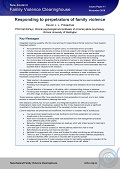 Issues Paper 11, November 2016
Issues Paper 11, November 2016
Author: Devon L. L. Polaschek1, PhD, DipClinPsyc
1 Clinical psychologist and professor of criminal justice psychology, Victoria University of Wellington
Downloads
Key messages
Integrated response systems offer the most promise for responding to family violence in New Zealand. Integrated systems:
- Are built from the perspective of system users, not individual service providers
- Include crisis services but also continue to provide support until change is firmly established
- Include response subsystems that cater for perpetrators, but also victims and families
- More New Zealand research is needed before any redesign proceeds, because good design requires knowledge about service users, and about current responses that is lacking
- Our communities hold expertise that is important to harness in any redesign. More researcher-practitioner collaboration should be built into any ongoing research and evaluation, because evidence-based practice is a process, not an outcome. Victims and victim advocates also hold expertise that is valuable to this research.
An integrated perpetrator response system includes co-ordination between crisis response and immediate containment, criminal and civil court proceedings, sentence or order compliance, risk monitoring and behaviour change components, and provides services based on risk and need. Necessary components include:
- “Best practice” risk assessment and reassessment processes that are used consistently with findings well documented
- Providing more dangerous perpetrators more oversight and assistance than less dangerous cases
- Prompt detection of increases in risk status, with a corresponding change in response
- Providing case managers for those with high and complex needs (e.g., mental health, alcohol and other drugs, housing) who co-ordinate and monitor planned responses.
These response systems offer more opportunities to hold perpetrators to account, and in turn, better account to victims for their efforts in keeping them safe.
New Zealand currently has no such system, and integrated systems are difficult to build and challenging to make work. Developing a system like this in New Zealand will require a significant investment in funding and the development of the necessary human resources.
Current responses are piecemeal and insufficient, and mired in a complex web of bureaucracy.
- Four government departments provide funding for short term perpetrator non-violence programmes in the community
- More work is needed to develop better risk assessment and risk management practices across different parts of the system
- Behaviour change-oriented programmes are relatively short with limited scope for tailoring to the heterogeneity of perpetrators
- Level and type of service is based on referral pathway rather than risk or need
- Self-referrals are growing, but most are unfunded
- Methods for engagement with victims and families for safety monitoring are still developing
- There is a lack of recognition in service provision models that contact between perpetrators, victims and families often continues or resumes after a specific episode
- A sustained programme of public education similar to road safety campaigns is needed “at the top of the cliff”, to increase the impact of these “bottom of the cliff” efforts.
Recommended citation
Polaschek, D. (2016). Responding to perpetrators of family violence. Auckland, New Zealand: New Zealand Family Violence Clearinghouse, University of Auckland.
ISSN: 2253-3222, published online only.
Feedback
The Clearinghouse welcomes your feedback. Please email us - we would love to hear your comments on this issues paper.


